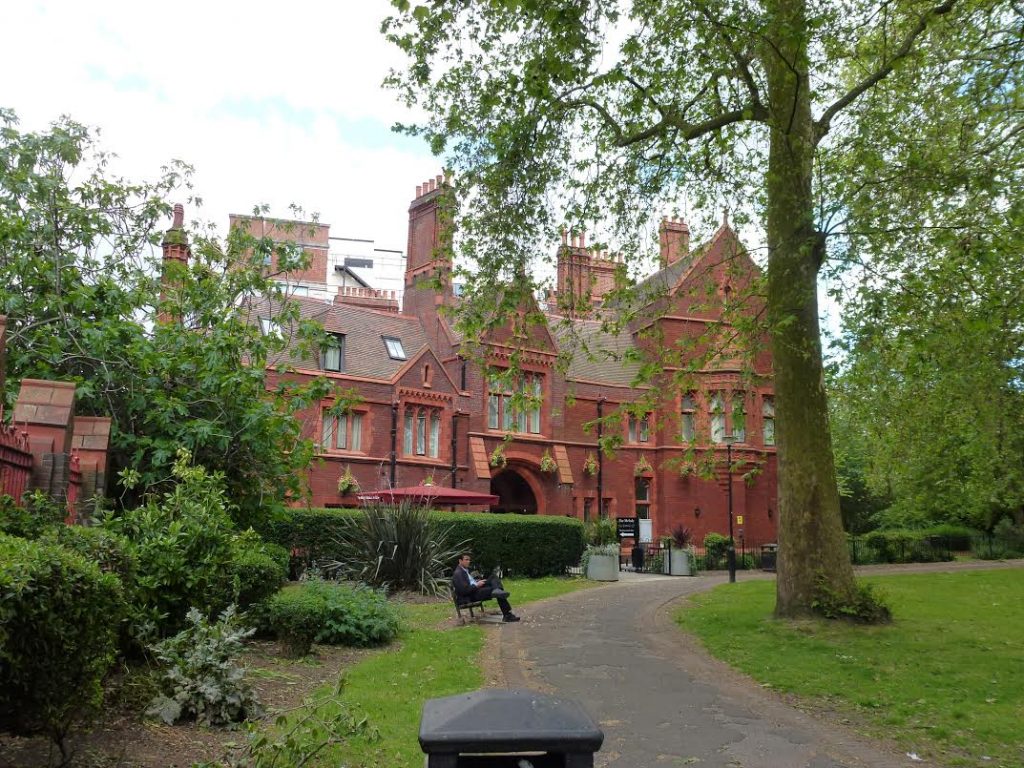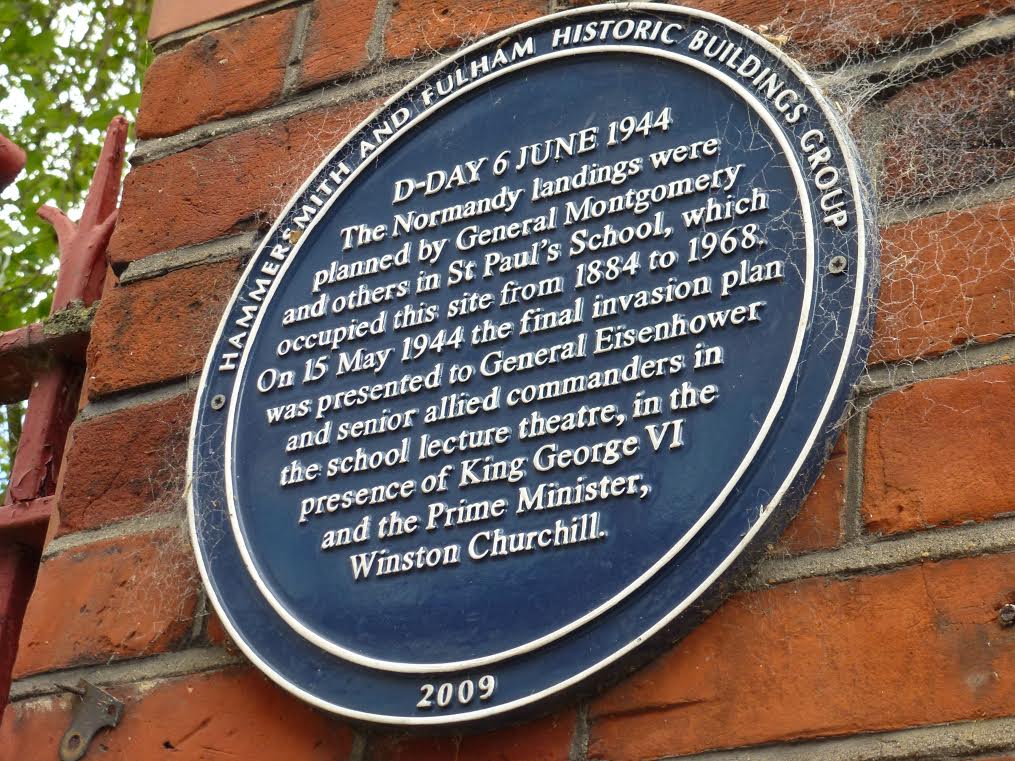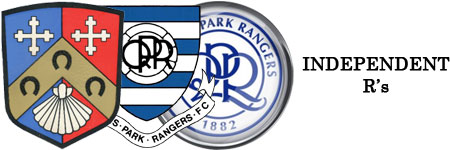Following our latest trip to the Hammersmith archive, Bernard Lambert, Colin Woodley and I headed up the Hammersmith Road to ‘Latymers’ for some lunch.
Whilst taking a photograph of the pub, Colin noticed an interesting building situated through the trees. A closer inspection revealed a blue plaque on the outside wall that commemorated the planning of the D-Day landings in 1944.
 Dan Hodges wrote an interesting article on the subject for the local newspaper in 2009 following the unveiling:
Dan Hodges wrote an interesting article on the subject for the local newspaper in 2009 following the unveiling:
‘It has been 65 years since Allied troops stormed the French beaches in a daring attempt to drive back the Nazis, thereby hastening the end of the Second World War.
But while the D-Day landings and their outcome are well documented, less well known is the fact that the whole finely tuned operation was orchestrated in the heart of Hammersmith by Generals Montgomery and Eisenhower.
The Command Centre was St. Pauls School in Hammersmith Road, where Montgomery had been educated at the start of the century. The school had been lying empty after the pupils and their teachers were evacuated to the Berkshire countryside to escape the German bombs.
All that survives of the old school, which moved to Barnes in the late 1960’s, is the old high master’s house, an open space and the pillars of its original gates.
But now, thanks to the efforts of Hammersmith and Fulham Pensioners’ Forum and Hammersmith Historic Buildings Group, the importance of the site has been recognised with a plaque commemorating its wartime role.
Veterans of several wars joined members of the two organisations as the Mayor, Councillor Alex Karmel, unveiled the plaque on Saturday.
 The plaque reads: ‘D-Day 6th June 1944. The Normandy landings were planned by General Montgomery and others in St. Paul’s School, which occupied this site from 1884 to 1968. On 15 May 1944 the final invasion plan was presented to General Eisenhower and senior allied commanders in the school lecture theatre, in the presence of King George V1 and the Prime Minister, Winston Churchill.’
The plaque reads: ‘D-Day 6th June 1944. The Normandy landings were planned by General Montgomery and others in St. Paul’s School, which occupied this site from 1884 to 1968. On 15 May 1944 the final invasion plan was presented to General Eisenhower and senior allied commanders in the school lecture theatre, in the presence of King George V1 and the Prime Minister, Winston Churchill.’
Montgomery’s office at the school operated in the high master’s old room, a place the general had never entered as a boy, despite having been an outstanding pupil. He later wrote:
“Although I had been a school prefect, captain of the 1st XV, in the cricket X1 and in the swimming team, I never entered the room before. I had to become a commander-in-chief to do so.”
The new plaque is the third to be put up in Hammersmith following a campaign by the Historic Buildings Group to preserve the history of important sites. The first was installed on St. Vincent’s Care Home in Queen Caroline Street and the second at Henry Moore’s studio in Adie Road.
Chairman Angela Dixon said: “Our borough has many interesting buildings and places but passers-by often don’t know their history. The planning of D-Day was an important historical event that took place in our borough and we are delighted to help commemorate it.”
Today members of St. Mary’s Church still recall the roar of German bombers overhead, and some believe the Nazis were targeting the school because they had intelligence about the men at work inside it.
The Germans came close – on June 16, 1944, the church in Edith Road suffered a direct hit from a V1 flying rocket and was completely destroyed. Miraculously, no one was killed, as evening service had just finished and worshippers had emptied out on to the streets.
Heather Armitage, 67, secretary of the Pensioners Forum, said: “The congregation had gone home and the verger had a premonition. He heard the air-raid sirens, so he didn’t wash the church silver but instead locked it away in a safe. The church was destroyed. Now on Remembrance Sunday, we still bring out the silver.”
She added: “A number of our pensioner members lived in the area during the Second World War and some remember seeing Monty about the place as he lived in Latymer Court at the time.”
“I have felt for a long time that these events should be properly commemorated and am delighted the plaque will tell passers-by about what happened here.”
After operating for years in temporary accommodation, St. Mary’s Church was finally re-built on the site in 1961.’
Steve Russell
(My thanks to Colin Woodley for taking both pics)

Yes Steve. Really interesting history of the site.
D-Day was delayed by one day due to the weather conditions. I particularly remember D –Day as on 6th June I was sitting with the form in the Geography room at Acton County School which faced south. From about 11 am onwards we had with tremendous noise what looked like the whole of the Royal Air Force flying right overhead, each with their special D-Day recognition markings being the black and white stripes under the wings. One of the other teachers entered the room and told us the invasion had started. This continuous flight made up of what seemed like hundreds of aircraft lasted for about two hours. Need I say we did little work after this and I think the Form Master disappeared from the room for some reason ?
Full marks to the two local organisations for putting the blue plaque up.
Without them we would not know about the amazing history.
Interesting comment Peter Barnes. Thanks for that.